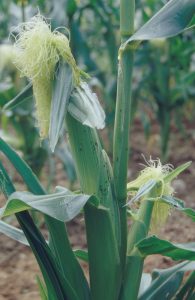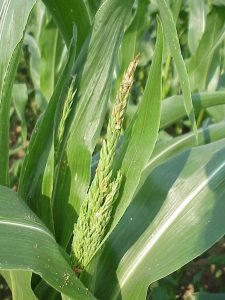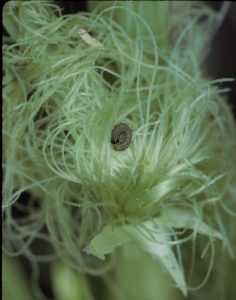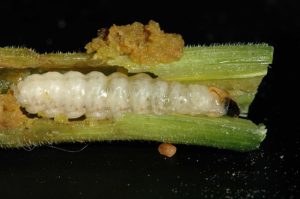Sweet Corn IPM Newsletter – No. 7 – August 5, 2022

Sweet Corn IPM Newsletter – No. 7 – August 5, 2022
SILKING CORN THREATENED
Corn Earworm, Fall Armyworm, Western Bean Cutworm in Higher Numbers
SITUATION
Very hot, dry conditions have pushed corn maturity and led to drought stress in unirrigated fields across the state. Drought stress during the pollination stage may lead to poor ear fill at harvest. Moth counts of corn earworm, fall armyworm, and western bean cutworm remained high enough to warrant silk sprays at most locations this week.

European corn borer: Larval feeding injury was not over the 15% control threshold for pre-tassel corn at any of our scouting sites. Moth captures in pheromone traps were over the 5-moth threshold for silking corn in Sabattus and Monmouth. Both of these sites are also on a spray interval for corn earworm, which should also provide protection against European corn borer.
Corn earworm: Moth counts have been high enough to require spray intervals at most locations this week. A 6-day spray interval for fresh silking corn was recommended at one Dayton site. A 5-day spray schedule was recommended for Bowdoinham, one Dayton site, Garland, one Lewiston site, Palmyra, Sabattus, and Wayne. A 4-day spray interval was recommended in Biddeford, Cape Elizabeth, New Gloucester, Monmouth, and one Wells site. All other sites were below threshold.

Fall armyworm: Fall armyworm activity increased at some sites this week, but distribution from site to site is quite variable. Moth counts were over the three-moth threshold for silking corn in Biddeford, Cape Elizabeth, one Dayton site, Farmington, Garland, Lewiston, New Gloucester, and one Wells site. The Farmington and Lewiston sites were not on a spray interval for corn earworm, so a silk spray was recommended. All other sites should be covered by the corn earworm sprays. Larval feeding damage on leaves and tassels was found at several sites but was not over threshold.
Western Bean Cutworm: Moths numbers continue to increase, ranging from 7 to 143 at our trapping locations, so growers should be prepared to protect any silking corn that is not under a spray interval for corn earworm. We have not yet found any larval feeding damage in the field.

Squash vine borer: Moths counts continue to be over the 5-moth per week threshold at most locations this week, so winter squash and pumpkin plantings should continue to be protected against squash vine borer at this time. See the New England Vegetable Management Guide for control options.

Powdery mildew infections on squash and pumpkins are reported around the state this week. See the New England Vegetable Management Guide for effective fungicide treatments. Start fungicide applications when symptoms (gray powdery spots on leaves) just begin to develop or when fruit are starting to enlarge. The IPM action threshold is 1 of 50 older leaves showing symptoms. Look at the lower as well as the upper surface of leaves when scouting. Use a 14-day spray interval with resistant varieties; 7-day with other varieties. Alternate the fungicide family (FRAC group) used to prevent resistance development.
Sincerely,
David T. Handley
Vegetable and Small Fruit Specialist
Highmoor Farm UMaine Extension Diagnostic
P.O. Box 179 Research Lab, Pest Mgmt. Unit
52 U.S. Route 202 17 Godfrey Drive
Monmouth, ME 04259 Orono, ME 04473
207.933.2100 1.800.287.027
Sweet Corn IPM Weekly Scouting Summary
| Location | CEW
Moths |
ECB
Moths |
FAW
Moths |
%Feeding
Damage |
Recommendations / Comments |
| Biddeford | 11 | 0 | 16 | 4% | 4-day spray interval for silking corn |
| Bowdoinham | 5 | 0 | 1 | 1% | 5-day spray interval for silking corn |
| Cape Elizabeth | 17 | 0 | 9 | 4% | 4-day spray interval for silking corn |
| Dayton I | 2 | 1 | 1 | 0% | 6-day spray interval for silking corn |
| Dayton II | 4 | 0 | 9 | 4% | 5-day spray interval for silking corn |
| Farmington | 0 | 2 | 4 | One spray for FAW on all silking corn | |
| Garland | 4 | 2 | 3 | 1% | 5-day spray interval for silking corn |
| Lewiston | 0 | 4 | 5 | 1% | One spray for FAW on all silking corn |
| Lewiston II | 4 | 4 | 10 | 5-day spray interval for silking corn | |
| Monmouth | 19 | 11 | 2 | 2% | 4-day spray interval for silking corn |
| New Gloucester | 11 | 4 | 30 | 4-day spray interval for silking corn | |
| Oxford | 1 | 4 | 1 | 3% | No spray recommended |
| Palmyra | 4 | 0 | 1 | 0% | 5-day spray interval for silking corn |
| Sabattus | 6 | 12 | 0 | 0% | 5-day spray interval for silking corn |
| Wayne | 4 | 0 | 0 | 0% | 5-day spray interval for silking corn |
| Wells I | 0 | 0 | 2 | 5% | No spray recommended |
| Wells II | 17 | 4 | 5 | 0% | 4-day spray interval for silking corn |
CEW: Corn earworm (Only fresh silking corn should be sprayed for this insect.)
ECB: European corn borer
FAW: Fall armyworm
| European Corn Borer Thresholds
Whorl stage: 30% or more of plants scouted show injury. Pre-tassel-silk: 15% or more of plants scouted show injury. Silk: 5 or more moths caught in pheromone traps in one week. |
Corn Earworm Spray Thresholds for Pheromone Traps
| Moths caught per week | Moths caught per night | Spray interval |
| 0.0 to 1.4 | 0.0 to 0.2 | No spray |
| 1.5 to 3.5 | 0.3 to 0.5 | Spray every 6 days |
| 3.6 to 7.0 | 0.6 to 1.0 | Spray every 5 days |
| 7.1 to 91 | 1.1 to 13.0 | Spray every 4 days |
| More than 91 | More than 13 | Spray every 3 days |
Thresholds apply only to corn with exposed fresh silk. Lengthen spray intervals by
one day if maximum daily temperature is less than 80°F.
IPM Web Pages:
http://extension.umaine.edu/ipm/
http://www.pestwatch.psu.edu/sweet_corn.htm
https://ag.umass.edu/integrated-pest-management/
Where brand names or company names are used, it is for the reader’s information. No endorsement is implied nor is any discrimination intended against other products with similar ingredients. Always consult product labels for rates, application instructions and safety precautions. Users of these products assume all associated risks.
The University of Maine is an equal opportunity/affirmative action institution.
